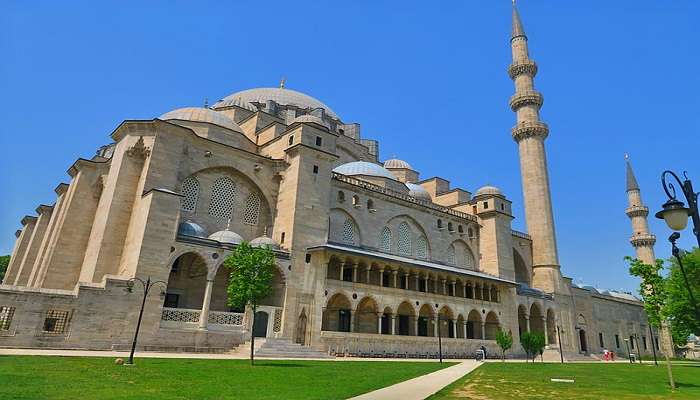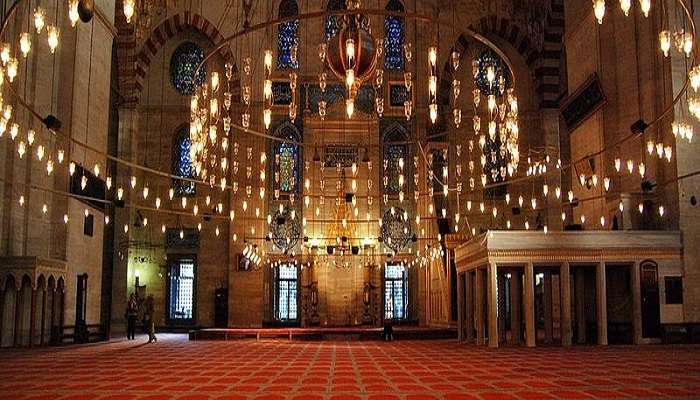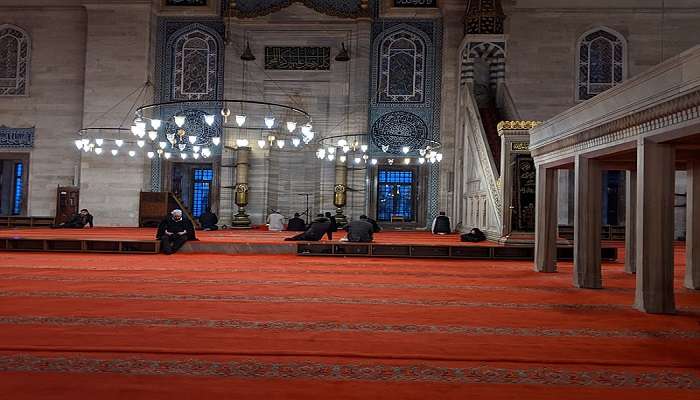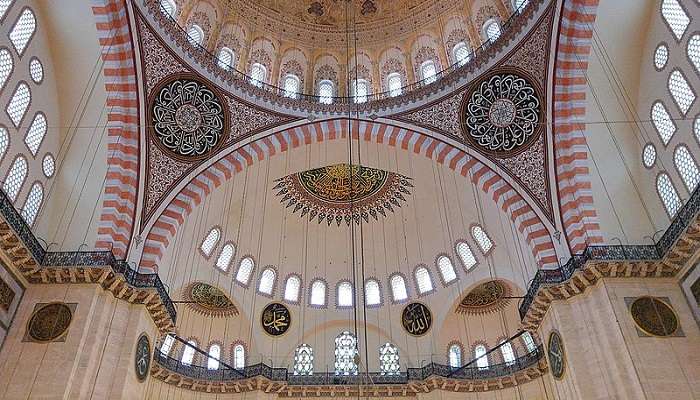Embark On A Spiritual Getaway At Suleymaniye Mosque In Istanbul

The Suleymaniye Mosque in Istanbul is one fine example of an iconic symbol of the country’s rich historical and cultural past. It stands as a brilliant achievement of the rich Ottoman architecture that interweaved spiritual grandeur with stark historical aesthetics. The Suleymaniye Mosque consists of a massive prayer hall, an educational institution, a medical facility, etc, reflecting the traditional roles of mosques in Islamic society. This majestic complex dominates the skyline of the city. Whether you are a nature lover, zealot, or a history buff, enjoy every second while you are still here.
Suleymaniye Mosque Overview

Istanbul, very remarkably borders two continents, namely, Europe and Asia, that are separated by the Bosphorus Strait. This very geographical location of the place has brought together two distinct cultures and civilizations over the years and still continues to do so. Located in northern Turkey, it serves as a bridge between the East and the West. Such a distinct history is what sets Istanbul as a rich and diverse city. Surrounded by rich history, the Suleymaniye Mosque reaches Istanbul’s skyline so high, it can be seen neighbouring other important sites like the Istanbul University and the ever-busy Spice Bazaar.
The Suleymaniye Mosque location also serves as a link between the traditional and the modern parts of Istanbul. One can reach the site via various modes of transport, public or private. The choice of location by the architect serves as an ideal strategy to attract locals and tourists alike for the idea of the traditional and the modern coexisting is highly appealing to the people and everyone would want to visit and witness such a remarkable site. Moreover, due to being situated on top of a hill, it serves as an ideal place for all those fascinated by the idea of experiencing an aerial view of the magnificent city.
Suleymaniye Mosque opening hours: 8:30 am- 4:45 pm almost every day of the week
Suleymaniye Mosque entrance fee:: Free
Must Read: Safari In Istanbul
Delve Into The History Of Suleymaniye Mosque

The Suleymaniye Mosque stands as one of the greatest examples of Ottoman architecture and the legacy of its architect, Mimar Sinan. One of the many facts about the Suleymaniye Mosque is that this mosque was constructed between 1550 and 1558 and Sultan Suleyman pictured this extravagant complex to be grander and more exquisite than the Hagia Sophia and that it would represent his empire’s wealth and rigidity. There are instances of Suleyman representing himself as the ‘Second Solomon’ and his construction projects appear to reflect the same.
Mimar Sinan, a brilliant architect of his time, created this mosque in such a way that it became one great site of interconnectedness, that of tradition and modernity.
Its interiors as well as the exteriors both portray an immaculate view into the rich history and age long traditions of Istanbul. The design of this complex is a great example of the result of blending Islamic and Byzantine architectural styles together. Throughout the historical timeline, this mosque has faced its own periods of decline and restoration. Be it natural calamities like earthquakes or manmade calamities like invasions, this grand site has always been resilient in power and stood strong on its grounds. Today, the Suleymaniye Mosque, located in Turkey, stands as a symbol of Istanbul’s heritage and is adored by Muslims around the globe.
Marvel At The Breathtaking Architecture Of Suleymaniye Mosque
Nestled on top of the highest hill, the Suleymaniye Mosque was built in the 16th century and is one of the most popular places of worship in the country that attracts people across borders. Learn about its intricate architecture and see it for yourself soon for the best time.
1. Minarets

The minarets of this mosque are one of the most significant features that contribute to the mosque’s majestic skyline profile. The two tall minarets were the tallest minarets in Istanbul around the time of construction. The shorter ones are positioned away from the taller ones in a way that the structure compliments each other. There are four tall minarets that occupy the courtyard of the mosque from all four sides. In the history of Ottoman architecture, this many minarets were only added to some mosques endowed by the sultan.
The minarets and the carefully crafted balconies hold utmost significance. The four minarets represent Sueiman’s position as the fourth sultan after the conquest of Constantinople. Whereas the ten balconies represent him being the tenth Ottoman sultan. The minarets are used to call people for the service. Their elevated position helps reach a wide area. Over the decades, the minarets have undergone many restorations and preservations to address damage caused by various natural elements.
Suggested Read: Cottages In Turkey
2. Prayer Hall

The prayer hall of this mosque is one brilliant example of architectural wonder and is one of the most magnificent parts of the Suleymaniye Mosque. It is the central part of the mosque where people gather for prayer services. The interior is one remarkable one that is decorated with intricate tiles, carvings, calligraphy, etc.
It is designed in such a way that it can accommodate a huge crowd easily and comfortably. The columns and arches of the mosque’s prayer hall stand tall and are designed in such a way that they don’t block the line of sight of the worshippers. The arches not only give support to the structure but also add to the aesthetic of the place.
3. Burials

Along with being one of the greatest examples of Ottoman architecture, the Suleymaniye Mosque in Istanbul houses many mausoleums of utmost significance. Among these, one that’s very noteworthy, belongs to Sultan Suleyman, one the the greatest Ottoman sultans who reigned from 1520 to 1566. This is one of the important features of the Ottoman tradition of sultanic mausoleums being a part of the mosque complex.
The mausoleum’s dome is comparatively simpler than the outer structure of the dome which is decorated with exquisite florals and geometric designs. One of the many important facts about the Suleymaniye Mosque is that these exquisite tiles and designs are a representation of one of the high points of Ottoman ceramic art. Besides the Sultan, the mausoleum complex also includes the burials of his wife Roxelana and other members of his family.
Suggested Read: Places To Visit In Pamukkale
4. Complex

Imperial mosques in Istanbul are primarily designed to serve both the religious and cultural needs of people of all stripes who visit the place. They incorporate various activities like prayer services, health care needs, education, etc. To accommodate all these facilities, mosques were built above massive structures and created vaulted rooms that were used for several uses.
The original complex consisted of the mosque itself, religious colleges and schools, medical institutions, guesthouses, public kitchens that usually served food to the needy, public baths, etc. One can indeed argue that Mimar Sinan created this mosque in such a way that it became one great site of interconnectedness, that of tradition and modernity.
Further Read: Things To Do In Turkey
Visit the Suleymaniye Mosque during your trip to Istanbul. It is considered to be one of the greatest achievements of Ottoman architecture and the very talented architect Mimar Sinan. Along with serving as a place of worship, it’s a symbol of the city’s rich cultural and historical heritage. It indeed stands as a brilliant achievement of the rich Ottoman architecture that interweaved spiritual grandeur with stark historical aesthetics.
For our editorial codes of conduct and copyright disclaimer, please click here.
Cover Image Source: Musa Ortaç for Pexels Commons
Frequently Asked Questions About Suleymaniye Mosque In Istanbul
What are some of the unique features of the Suleymaniye Mosque?
Some of the many unique features of the mosque is its central dome which is surrounded by smaller domes and arches.
Why was the Suleymaniye Mosque built?
The Süleymaniye Mosque was built as a tribute to Sultan Suleyman and the architect. As history buffs and architectural enthusiasts, one can have the best experience.
How big is the Suleymaniye Mosque?
It measures 194 feet long and 190 feet wide. The mosque is among the famous places for worship.
When was the Suleymaniye Mosque built?
It was built in 1557. Even today, it is preserved.
How many windows are in the Suleymaniye Mosque?
There are approximately 138 windows on the Suleymaniye Mosque.
People Also Read:
Mosques In Egypt Mosques In Ho Chi Minh City Spanish Mosques

Embrace the essence of surreal places around the world through perfect narratives with a touch of imagination. As a content writer, I weave my ideas and words together to create a vivid picture of alluring destinations. Embark on limitless adventures as you read thrilling travel stories.











